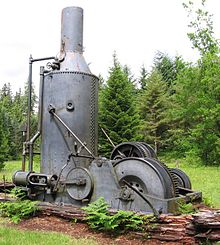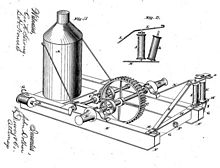Steam donkey: Difference between revisions
m Removed category Humboldt County, California (using HotCat) |
|||
| Line 49: | Line 49: | ||
[[Category:Logging]] |
[[Category:Logging]] |
||
[[Category:Log transport]] |
[[Category:Log transport]] |
||
[[Category:Humboldt County, California]] |
|||
Revision as of 16:02, 15 January 2010

Steam donkey, or donkey engine is the common nickname for a steam-powered winch, or logging engine widely used in past logging operations, though not limited to logging. They were also found in the mining, maritime, and nearly any other industry that needed a powered winch.
Design and usage
Steam donkeys acquired their name from their origin in sailing ships, where the "donkey" engine was typically a small secondary engine used to load and unload cargo and raise the larger sails with small crews, or to power pumps. They were classified by their cylinder type – simplex (single-acting cylinder), or duplex (a compound engine); by their connection to the winches (or "drums") – triple-drum, double-drum, etc; and by their different uses: high-lead yarder, ground-lead yarder, loader, snubber, incline hoist, etc. A good deal of the cable-logging terminology derived from 19th century merchant sailing, as much of the early technology originated from that industry.
A logging engine comprised at least one powered winch around which was wound hemp rope or (later) steel cable. They were usually fitted with a boiler, and usually equipped with skids, or sleds made from logs, to aid them during transit from one "setting" to the next. The larger steam donkeys often had a "donkey house" (a makeshift shelter for the crew) built either on the skids or as a separate structure. Usually a water tank, and sometimes a fuel oil tank was mounted on the back of the sled. In rare cases, steam donkeys were also mounted on wheels. Later steam donkeys were built with multiple horizontally-mounted drums/spools, on which were wound heavy steel cable instead of the original rope.
Method of operation

(Patent 256,553)
This describes the use of a steam donkey for logging operations. In the simplest setup, a "line horse" would carry the cable out to a log in the woods. The cable would be attached, and, on signal, the steam donkey's operator (engineer) would open the regulator, allowing the steam donkey to drag or "skid" the log towards it. The log was taken either to a mill or to a "landing" where the log would be transferred for onward shipment by rail, road or river (either loaded onto boats or floated directly in the water). Later a "haulback" drum was added, where a smaller cable could be routed around the "setting" and connected to the end of the heavier "mainline" to replace the line horse.
If a donkey was to be moved, one of its cables was attached to a tree, stump or other strong anchor, and the machine would drag itself overland to the next yarding location.
History

John Dolbeer, a founding partner of the Dolbeer and Carson Lumber Company in Eureka, California, invented the logging engine in August 1881. The patent (number: 256553) was issued April 18, 1882. On Dolbeer's first model, a 150-foot, 4½ inch manila rope was wrapped several times around a gypsy head (vertically mounted spool) and attached at the other end to a log.[1][2]
The invention of the internal-combustion engine led to the development of the diesel-powered tractor crawler, which eventually put an end to the steam donkey. Though some have been preserved in museums, very few are in operating order. A great number still sit abandoned in the forests, rusting in the spot where they dropped their fires not so long ago.
An operational steam donkey is on display and occasionally operated at Fort Humboldt State Historic Park in Eureka. A non-operational steam donkey accompanied by a plaque explaining the history of the machine is on permanent display at Grizzly River Run, an attraction at Disney's California Adventure. Another collection of steam donkeys is located at the Point Definance Park, Camp 6 Logging Museum located in Tacoma, Washington. The collection includes various steam donkeys, including one of the last very large ones built, and others at various stages of restoration.
On August 1, 2009 a Steam Donkey was officially unveiled at McLean Mill National Historic Site in Port Alberni, British Columbia. It is now the only commercially operating Steam Donkey in North America. Due to extreme fire risk, demonstrations of the donkey was not performed but the logs from previous test runs of the donkey that were loaded onto a truck were dumped into the McLean Mill millpond, representing the first steam-powered commercial logging operation in North America for decades. This machine continued to operate after R. B. Mclean shuttered the steam-powered McLean Mill site in 1965. It ran until 1972 and was abandoned on site. It was restored by the Alberni Valley Industrial Heritage Society in 1986 for Expo 86 and more recently was recertified for commercial use at McLean Mill. Agreements have been made with forest land owner Island Timberlands (owned by Brookfield Asset Managements) to log, mill, and sell, trees and lumber from the surroundings of McLean Mill.
Other uses
Steam donkeys were also found to be useful for powering other machines such as pile drivers, slide-back loaders (also known as slide-jammers), and cherry-pickers (a sled-mounted crane used for loading logs, that a grading crew had cut down, onto railroad cars).
An auxiliary engine on a sailing craft (which does propel the vessel) is still sometimes informally known as "the donk".
See also
- Yarder – a larger steam-powered logging machine
- Lidgerwood – manufacturer of steam-powered logging equipment
- Geared steam locomotive – often used on forestry railways
References
- ^ Wilma, David (March 1, 2003). "John Dolbeer invents the donkey engine and revolutionizes logging in August 1881". HistoryLink.org. Retrieved 2007-02-27.
{{cite news}}: Cite has empty unknown parameter:|coauthors=(help) - ^ Richard L. Williams, The Loggers, (New York: Time-Life Books, 1976), 112-113; ISBN 0-8094-1527-5
External links
- The Anatomy of a Steam Donkey – (image)
- Steam Donkeys
- The Donkey Engine – Steam & Engine of Australia
- Turtle Bay Exploration Park's Dolbeer Steam Donkey (video)
- Steam Power – Pacific County Historical Society and Museum
- University of Washington Libraries: Digital Collections:
